ESCAMBIA RIVER ELECTRIC COOPERATIVE JANUARY 2024


ESCAMBIA RIVER ELECTRIC COOPERATIVE JANUARY 2024

Local students harvest, wash and bag food during the Farm to City event. Page 4
PHOTO BY CORTNEY OWENS

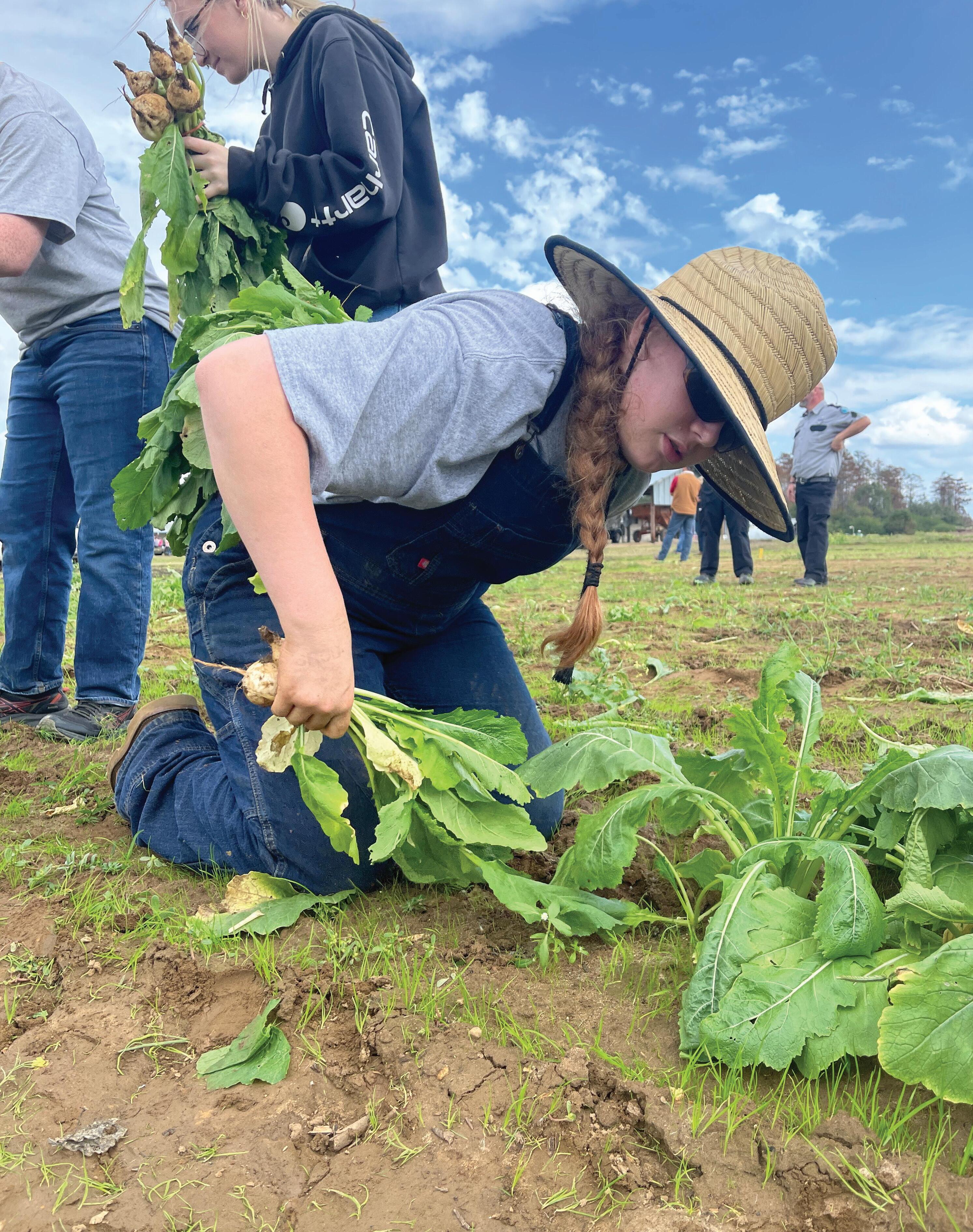
•
•









January 2024 • Volume 13, No. 3
CEO Michael Shepard
VICE PRESIDENT OF CONTENT Leon Espinoza
EDITORIAL DIRECTOR Mike Teegarden, CCC
DEPUTY EDITORIAL DIRECTOR
Noble Sprayberry
SENIOR EDITOR Jennifer Paton, CCC
FLORIDA CURRENTS EDITORS
Chasity Anderson, CCC; Valeri Pearon
ASSISTANT EDITORS Victoria Hampton, CCC; David Herder, CCC
ASSOCIATE EDITOR
Nina Todea
PUBLICATIONS PRODUCTION MANAGER
Elizabeth Beatty
PUBLICATIONS COORDINATOR
Alyssa McDougle
Members acknowledge that $4.31 a year, plus postage, is the cost to publish 12 issues a year of FLORIDA CURRENTS ISSN 23276304 (USPS 8300). Published by Pioneer Utility Resources Inc., 5625 NE Elam Young Pkwy. Ste. 100, Hillsboro, OR 97124—a not-for-profit Oregon cooperative corporation—the magazine serves the communication needs of consumerowned electric utilities in Florida. Preferred Periodicals postage paid at Hillsboro, OR 97123 and at additional mailing offices.
Postmaster: Send address changes to 5625 NE Elam Young Pkwy., Ste. 100, Hillsboro, OR 97124-6422.
HOW TO CONTACT FLORIDA CURRENTS
Subscription services:
Nonmember subscriptions $15 U.S. a year; $25 foreign a year. Prepayment required. Allow 4-8 weeks for first issue. Identify local edition desired. Have a problem receiving your magazine? Utility members should contact their utility office. Nonmembers call 503-357-2105 or email mailingdept@pioneer.coop.
Back issues:
Back issues and extra copies are $3 each, prepayment required. Supply is limited. Identify edition, month and year. Call first to check availability. Contact Pioneer Utility Resources: P.O. Box 1306, North Plains, OR 97133-1306; 503-357-2105; email: mailingdept@pioneer.coop.
DISPLAY ADVERTISING INQUIRIES
American MainStreet Publications 611 S. Congress Ave. Ste. 504 Austin, TX 78704-1714; 800-626-1181 or 512-441-5200; amp.coop.
© 2024 Pioneer Utility Resources. All rights reserved. Reproduction in whole or in part without written permission is prohibited. Direct reprint requests to editor@floridacurrents.com For more information, visit www.pioneer.coop.
“Energy efficient” is a phrase we often see on product labels or advertisements, but being more energy efficient is something we all can do to manage use and keep costs low.
Looking for the most efficient way to power your home or business is part of what we do every day at Escambia River Electric Cooperative.
EREC examines a variety of wholesale generation resources to serve members, and it looks ahead to ensure members have the reliable, low-cost energy needed for the future. This means contracting for long-term power purchases and buying power from the market to meet energy needs at the lowest cost.

Escambia River also provides information and materials to guide members through steps to maximize energy efficiency. Cooperatives provide resources such as energy-efficiency loans (for making energy-saving improvements to your home), rebates (on certain high-efficiency heating and cooling systems) and discounts on high-efficiency water heaters.
Contact your local cooperative at 850-675-4521 to find out about programs available to you.
As a member, you can improve the energy efficiency of your home or business. The following options allow you to carry out daily routines while consuming less energy:
• Switch to LED lightbulbs and modern Energy Star-rated appliances, which use less energy to provide light or complete a task. LED bulbs save you money and last up to 25 times longer than incandescent bulbs.
• According to the IRS, if you make qualified energy-efficient improvements to your home, you can qualify for a tax credit of up to $3,200. These improvements include upgrading insulation and replacing exterior doors, windows and skylights. Find out more at irs.gov.
• Improve your power management. Whether it’s a computer that’s set to go to sleep after a certain time, or using programmable thermostats to control heat or AC, managing your power use is critical to lowering energy use.
• When it comes to choosing products, nothing can save you more than choosing an energyefficient heat pump.
Find out more about how you can improve your home’s energy efficiency at energy.gov.
For additional content, search @FloridaCurrents on your favorite social media sites and floridacurrents.com.

Florida Keys research may help protect Caribbean reefs
Up Close, Page 10
Esports growth offers Florida students community and opportunity Spotlight, Page 12
Snacking Fun With a Pop In the Kitchen, Page 16
Story and photos by Cortney Owens
For the sixth year, the University of Florida Institute of Food and Agricultural Sciences West Florida Research and Education Center joined forces with Feeding the Gulf Coast and Waterfront Rescue Mission to provide meal boxes for 1,000 families this past Thanksgiving.
More than 200 agriculture students spent one of their fall break days harvesting collards and turnips and a bagging sweet potatoes for this year’s Farm to City event.
Students involved in agricultural programs from Northview High School, Beulah Academy FFA and 4-H, Tate High School, Beulah Middle School, Barrineau Park 4-H, Jay High School, Milton High School, Central School and Boy Scout Troop 400 got their hands dirty for a wonderful cause.
This event would not have been possible without the support of sponsors such as Escambia River Electric Cooperative.
“We are so proud of these students for stepping up and being a part of such a wonderful event,” EREC CEO Ryan Campbell says. “This is a very unique and special experience for our community as it teaches students about the economic, environmental, and societal benefits of agriculture and, in turn, gives families fresh produce to put on their tables.”
Ag students didn’t mind sacrificing one of their days off for the cause.
“I really was just glad to be spending the day outdoors with my friends,” says Chase Dooley, a Jay High School ninth grader and FFA member.
“We filled a lot of bags with food, and I think we were all inspired to be ambassadors for future generations.”

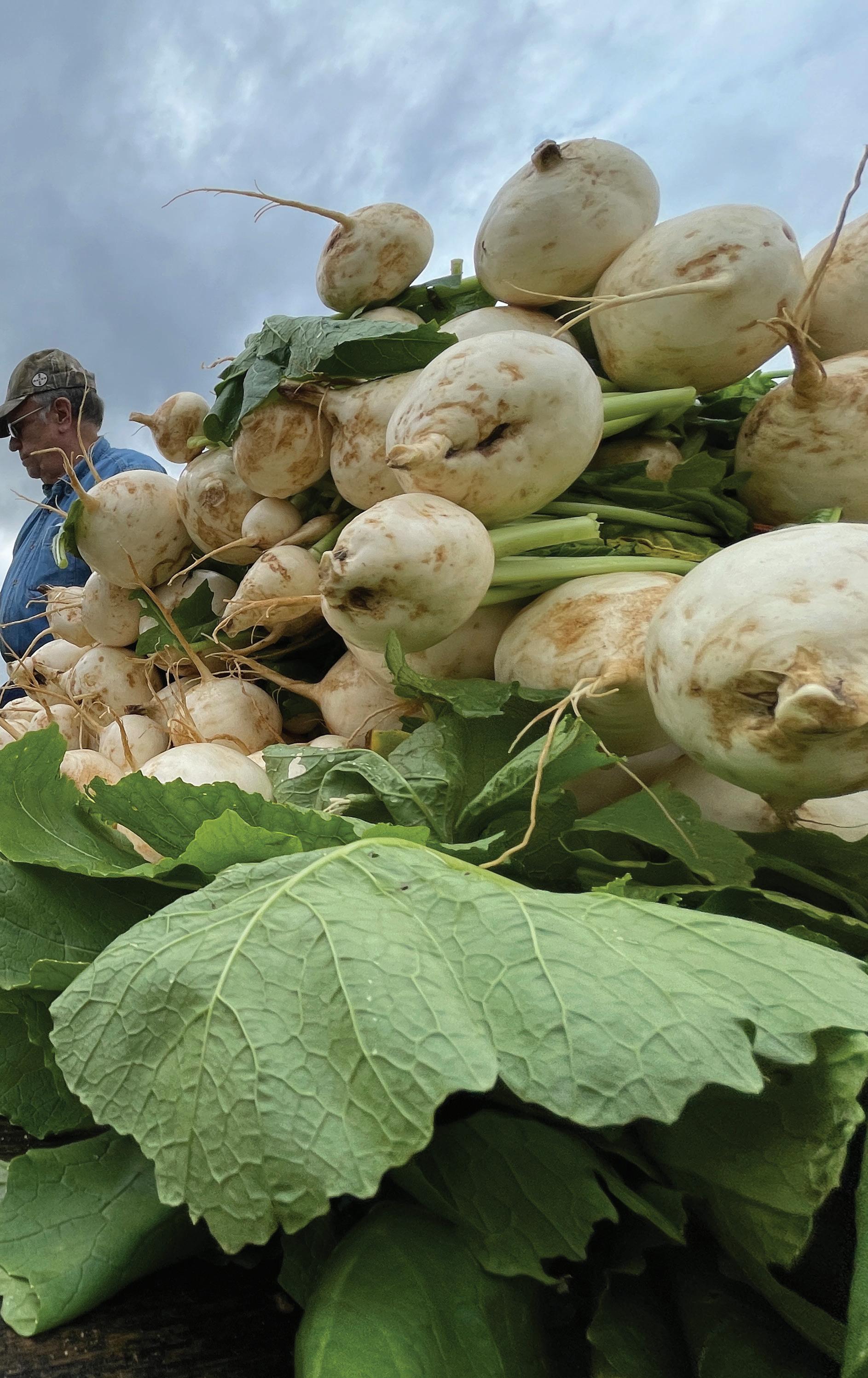

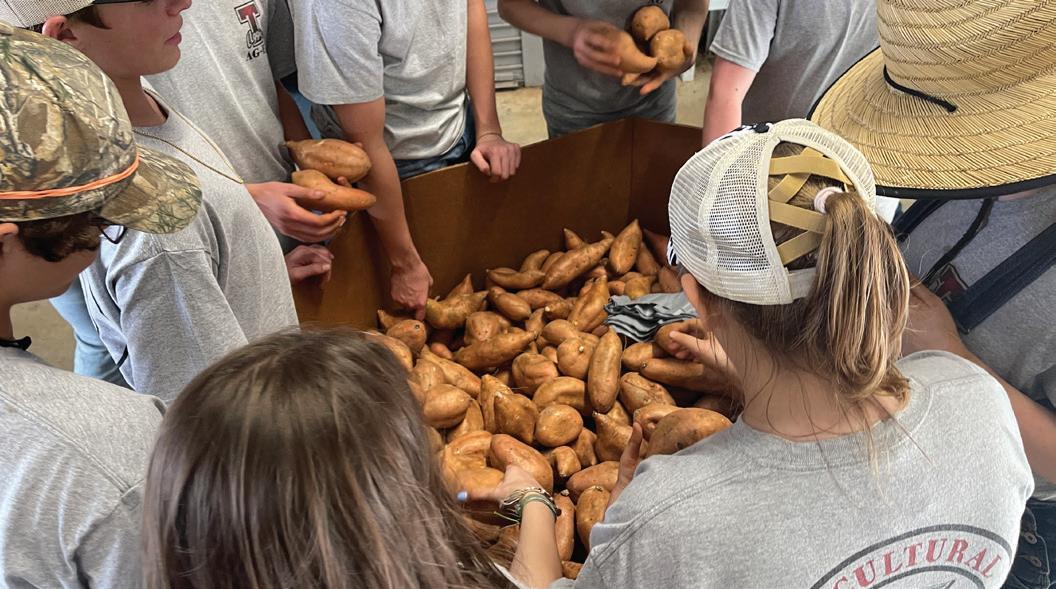
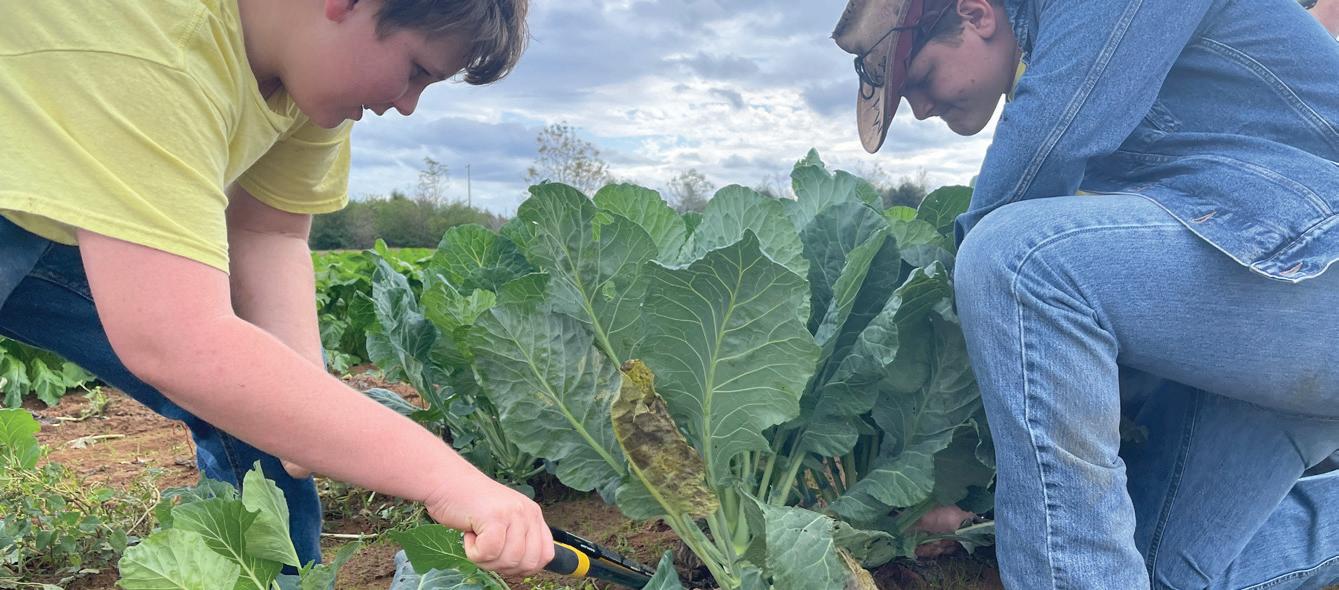



By Maura Giles
Electricity plays an essential role in everyday life. It powers our homes, offices, hospitals and schools. We depend on it to keep us warm in the winter and cool in the summer, charge our phones and binge TV shows. If the power goes out, even briefly, our lives can be disrupted.
The system that delivers your electricity is often described as the most complex machine in the world, and it’s known as the electric grid.
What makes it so complex? We all use different amounts of electricity throughout the day, so the supply and demand for electricity is constantly changing. For example, we typically use more electricity in the mornings when we start our days, and in the evenings when we cook dinner and use appliances.
Severe weather and other factors also affect how much electricity we need.
The challenge for electric providers is to produce, purchase and plan for enough electricity so it’s available exactly when we need it. Too much or too little electricity in one place can cause problems. To make sure the whole system stays balanced, the electric grid must adjust in real time to changes and unforeseen events.
At its core, the electric grid is a network of power lines, transformers, substations and other infrastructure that spans the entire country.
However, it’s not just a singular system. It’s divided into three major interconnected grids: the Eastern Interconnection, Western Interconnection and Electric Reliability Council of Texas. These grids operate independently but are linked to allow electricity to be transferred among regions when backup support is required.
Within the three regions, seven balancing authorities— known as independent system operators or regional transmission organizations—monitor the grid, signaling to power plants when more electricity is needed to maintain a balanced electrical flow. ISOs and RTOs are like traffic controllers for electricity.
Power plants can be thought of as factories that make electricity using various energy sources, such as natural gas, solar, wind and nuclear energy. Across the United States, more than 11,000 power plants deliver electricity to the grid.
Escambia River Electric Cooperative receives power from its generation and transmission co-op, PowerSouth. EREC works closely with PowerSouth to provide electricity at the lowest cost possible.
Being part of a G&T benefits members like you by placing ownership and control in the hands of your co-op, prioritizing affordability and reliability, supporting local economic development, and fostering a sense of community.
To get the electricity from power plants to you, we need a transportation system.
High-voltage transmission lines act as highways for electricity, transporting power long distances. These lines are supported by massive towers and travel through vast landscapes, connecting power plants to electric substations.
Substations are like pit stops along the highway, where the voltage of electricity is adjusted. They play a crucial role in managing power flow and ensuring electricity is safe for use in homes and businesses.
Once the electricity is reduced to the proper voltage, it travels through distribution power lines, like the ones on the side of the road. Distribution lines carry electricity from substations to homes, schools and businesses.
Distribution transformers, which look like metal containers on the tops of power poles or large green boxes on the ground, further reduce the voltage to levels suitable for household appliances and electronic devices.
After traveling through transformers, electricity reaches you—to power everyday life.
EREC is proud to be your local, trusted energy provider. From the time it’s created to the time it’s used, electricity travels great distances to be available at the flip of a switch. That’s what makes the electric grid our nation’s most complex machine—and one of our nation’s greatest achievements.
step 1
GENERATION
Power plants generate electricity using a variety of energy sources, like solar, natural gas, nuclear and wind energy.
The electric grid is considered one of the most complex machines in the world, delivering the electricity we need for everyday life.
step 5
DISTRIBUTION SUBSTATION
These substations lower the voltage again so the electricity is ready to travel on distribution lines.
step 6
DISTRIBUTION LINES
Lower-voltage electricity travels through distribution lines, like the ones you typically see on the side of the road.
step 2
STEP-UP
TRANSFORMER
A step-up transformer increases the voltage to push the electricity over long distances.
step 3
step 7 FINAL STOP


A transformer located on the ground or a utility pole reduces the voltage a nal time, then electricity is sent inside your home, school or business.







High-voltage electricity travels over long distances through these lines.



step 4

TRANSMISSION LINES


TRANSMISSION SUBSTATION
Voltage is lowered at a transmission substation so electricity can travel across the local distribution system.
















From the rich maritime heritage of whaling towns to quaint island villages and grand seaside mansions of the Gilded Age, our small, comfortable ships can take you to the heart of New England’s most treasured destinations. Be welcomed back to your home away from home, where you can delight in the warm camaraderie of fellow guests and crew.












































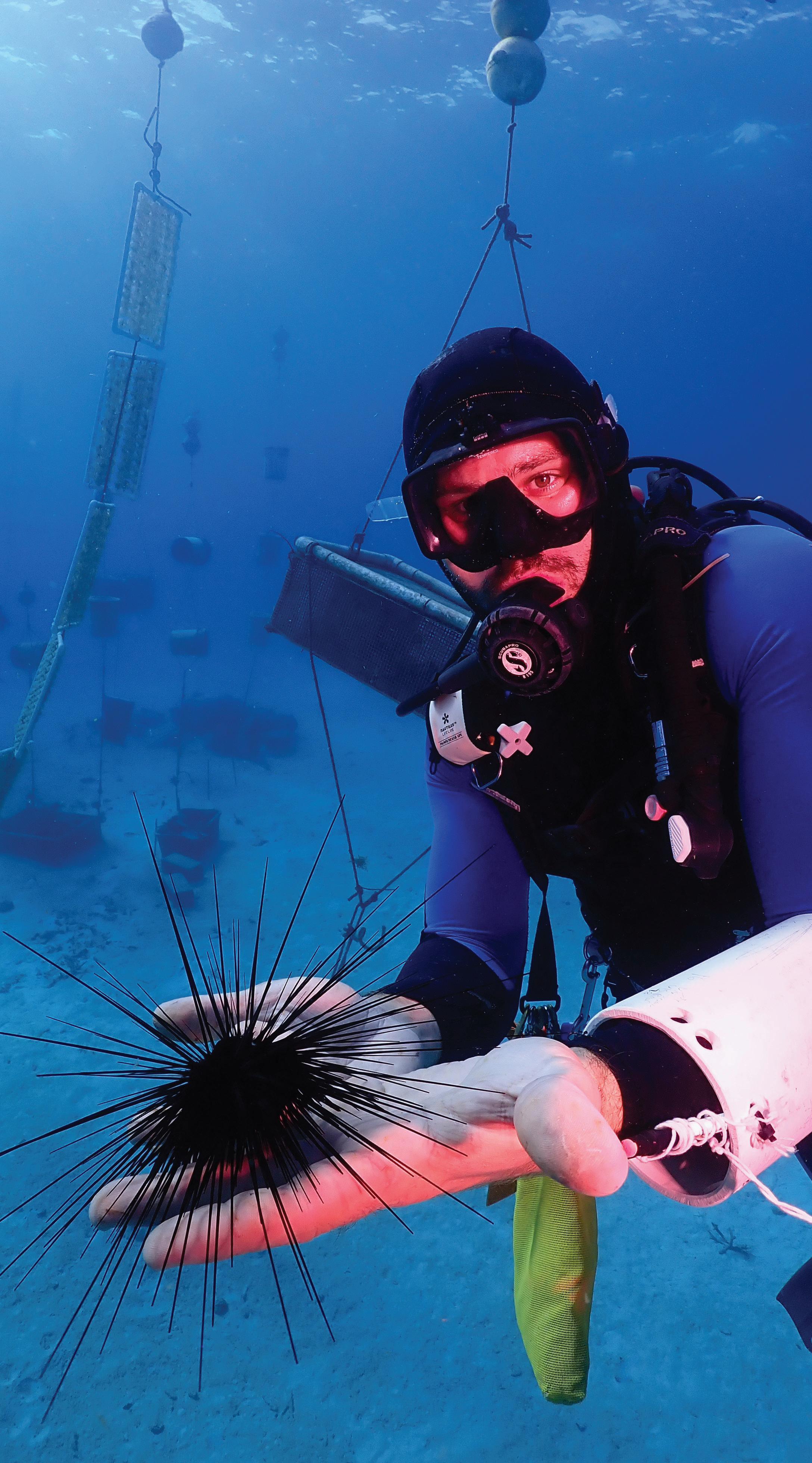
By Dan Eidsmoe
Beachcombers, scuba divers and snorkelers typically avoid urchins. If you step on one or accidentally bump into it, your skin can be punctured by the creature’s needle-like spines. Once under the skin, the spines are difficult to remove.
Florida Keys marine biologist Jim Brittsan, however, is excited by the round spiny creatures. As he explains, a healthy urchin population in the Caribbean is vital to the health of coral reefs.
Jim, 27, works with multiple coral restoration organizations throughout the Keys. Beginning as a selffunded project, he now has financial support from the state of Florida and is raising urchins in the wild with hopes of reintroducing them to Florida’s coral reef.
Urchins are important to the reefs because they eat algae. Out-of-control algae growth kills coral reefs by cutting off room for growth and diminishing the amount of sunlight and oxygen reaching the coral.

Jim says urchins are like underwater gardeners.
“When sea urchins consume

































algae, they create open spaces on the reef that can be colonized by new coral babies,” he says.
Algae growth and coral bleaching have decimated coral reefs. The Keys have lost 80% of their coral in the past 30 years. Many factors are believed to contribute to coral bleaching worldwide, including pollution, climate change, warming oceans and overfishing. In the Keys, water temperatures are frequently over 85 degrees in the summer. That high water temperature prompts algae growth that can smother coral and inhibit the settlement of coral larvae.
Jim, a Columbus, Ohio, native, is so optimistic about the prospects for raising sea urchins that he turned down scholarship opportunities for graduate studies in Puerto Rico and at Bowling Green University in Ohio.
Jim’s father, Mike, was the Columbus Zoo and Aquarium curator. As a student at Bowling Green University, Jim learned that everything in nature is interconnected.







































“If our oceans die, life in Ohio and landlocked states would also be adversely affected,” Jim says. “I knew coral reefs were in trouble, and I learned how important urchins were to the entire equation.”
Jim says the well-being of sea urchins has never been more important than now. Although once seen as a nuisance, the long-spined urchins are known as the greatest grazers of the Caribbean and caretakers of coral reefs.
The problem is, they are dying throughout the Caribbean. According to the National Park Service, long-spined sea urchins commonly live between the shoreline to depths over 100 feet. At low tide, they take shelter from waves in rock cavities. Although protected by the Florida Fish and Wildlife Conservation Commission, their numbers throughout the Keys have never been lower. Some scientists blame a microscopic, single-cell parasite for the die-off, which took hold in early 2022, but the resarch continues.
Jim describes one sea urchin species, Diadema antillarum, as a keystone species for Caribbean coral reefs. Before 1983, it was the most prevalent herbivore in the Caribbean. Today, it is nearly nonexistent.
“A diverse population of herbivores is important for maintaining a healthy balance between algae and coral on the reef and for supporting the many other organisms that rely on this ecosystem,” he says. “By restoring populations of different herbivorous species, we can help to support the health and resilience of Caribbean coral reefs.”
Jim hopes his urchin “babies” growing in an environment closely replicating the coral reef learn to eat algae off coral before being placed permanently into the wild. Every 15 to 30 days, he collects coral rubble covered in algae from the coral nurseries and puts it into the nursery with the baby urchins.
By grazing on the rubble, the young urchins learn to hide in the nooks







and crevices of the reef. They also eat everything in their path, not just the algae.
“The dead coral has many things growing on it,” Jim says. “In this setting, the urchins get a much more diverse diet of alga types. They also get bits of calcium carbonate from the rocks, which makes their spines hardier and increases spine density.”
In Jim’s nursery—the first of its kind in the Keys—coral trees and urchin shelters hang on monofilament lines tethered to the ocean floor and are held upright in the water by a buoy. The nursery integrates repurposed materials such as ice cream buckets, crates, ceiling tiles and Gatorade bottles. The cages, which Jim designs, are made from vinyl-coated wire and PVC frames. Sea water can pass through the boxes while protecting the growing urchins from fish predators.
“We hope to create a low-cost method to rear thousands of these herbivores,” he says. “A mariculture system like ours could be a game changer.”
With hopes high for the success of his urchin family, Jim is optimistic he may be able to leave coral reefs in a healthier place.
“With this project, I get the strong sense that I can be part of the solution rather than the problem,” he says.
Virtually visit the nursery in this three-minute video: bit.ly/sea_urchin_nursery.





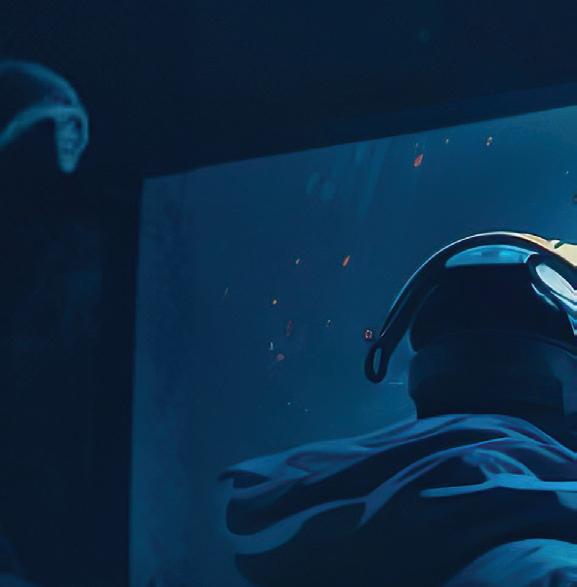

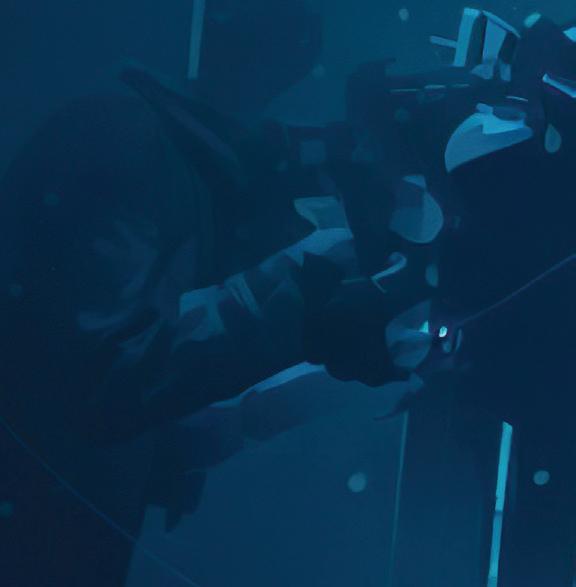
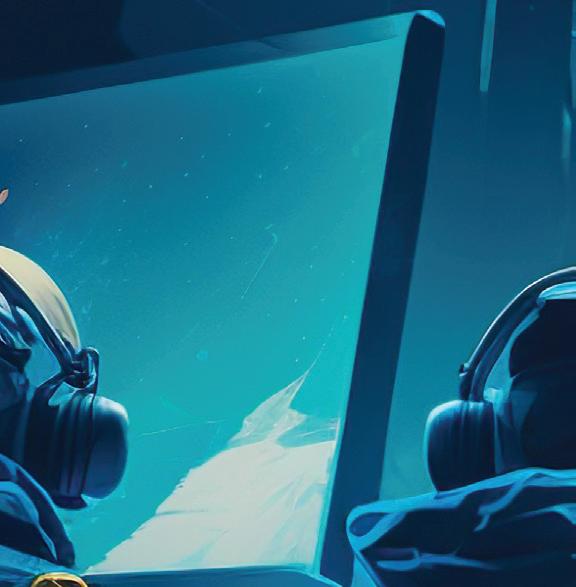
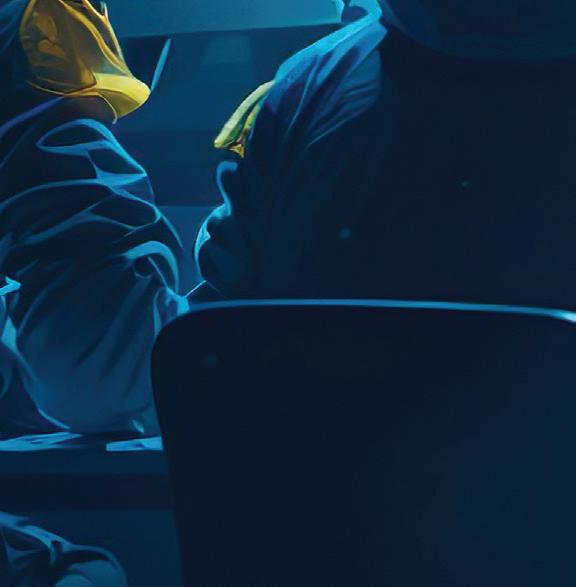


























Esports growth offers Florida students community and opportunity

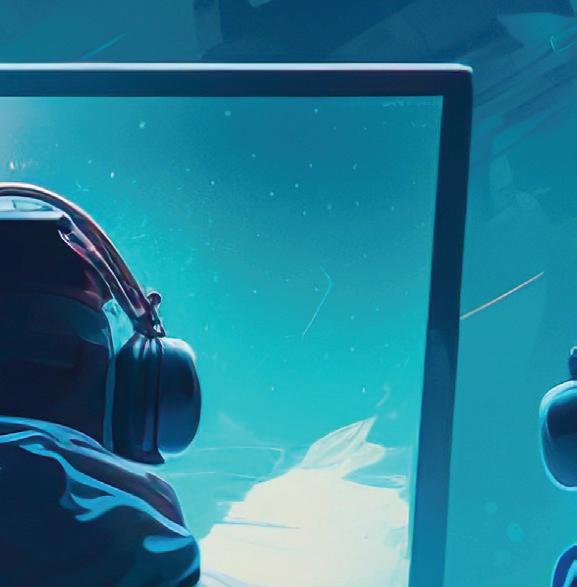

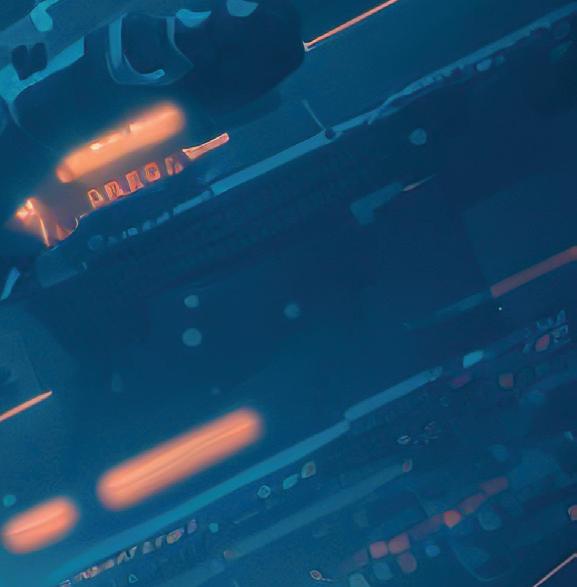



By Drew Woolley
When Ryley Griffin arrived at the Florida Institute of Technology in 2018, he was excited to pursue a chemical engineering degree while playing lacrosse for the Division II school. It wasn’t long, however, before he discovered the rigor of his studies and the time he needed to dedicate to the team weren’t a good mix.







Still, Ryley knew he was competitive by nature. In 2019, another game captured his imagination.
“I realized I was going to go insane if I wasn’t part of a team or doing some kind of competition,” he says. “I was very in love with a game called League of Legends. I had played in internet cafe tournaments with my friends in high school. I decided to try and start a team with Florida Tech, who at the time was actually looking at doing esports.”
Florida Tech had just begun consulting

with Dana Hustedt, the director of esports at Grand View University in Iowa who helped build one of the country’s first collegiate esports programs in 2017. She provided a checklist of tasks that needed to be completed if Florida Tech wanted to create a robust program of its own.



In 2021, Florida Tech hired Dana as director of its esports program.
Since then, the program has assembled varsity and junior varsity teams for games such as League of Legends, Super Smash Bros., Rocket League and Valorant, while also building a welcoming community for noncompetitive gamers and establishing a two-story Esports Center on campus.
“Being a tech school, there’s always going to be that overlap of STEM students and video games,” Dana says. “It’s a way to engage their student population if you aren’t excited about regular sports or debate or other extracurriculars. This is a way that many students now relate with

gaming as a community factor.”




As a former student-athlete, Dana—who played varsity softball at Grand View University—often describes esports to newcomers in traditional sports terms. The playing field might differ, but many of the skills required are the same, from highlevel communication to rapid-fire decision making.
“Take a game where there are five players on a team,” she says. “Like basketball, they all have a position or a lane. Every one of them has their own unique skill set and fundamentals they need to do during the game. And the preparation that takes is very similar.”
Ryley found the same to be true when he first discovered League of Legends. In high school, he entered weekend competitions with friends at a local Microsoft store, where they played for
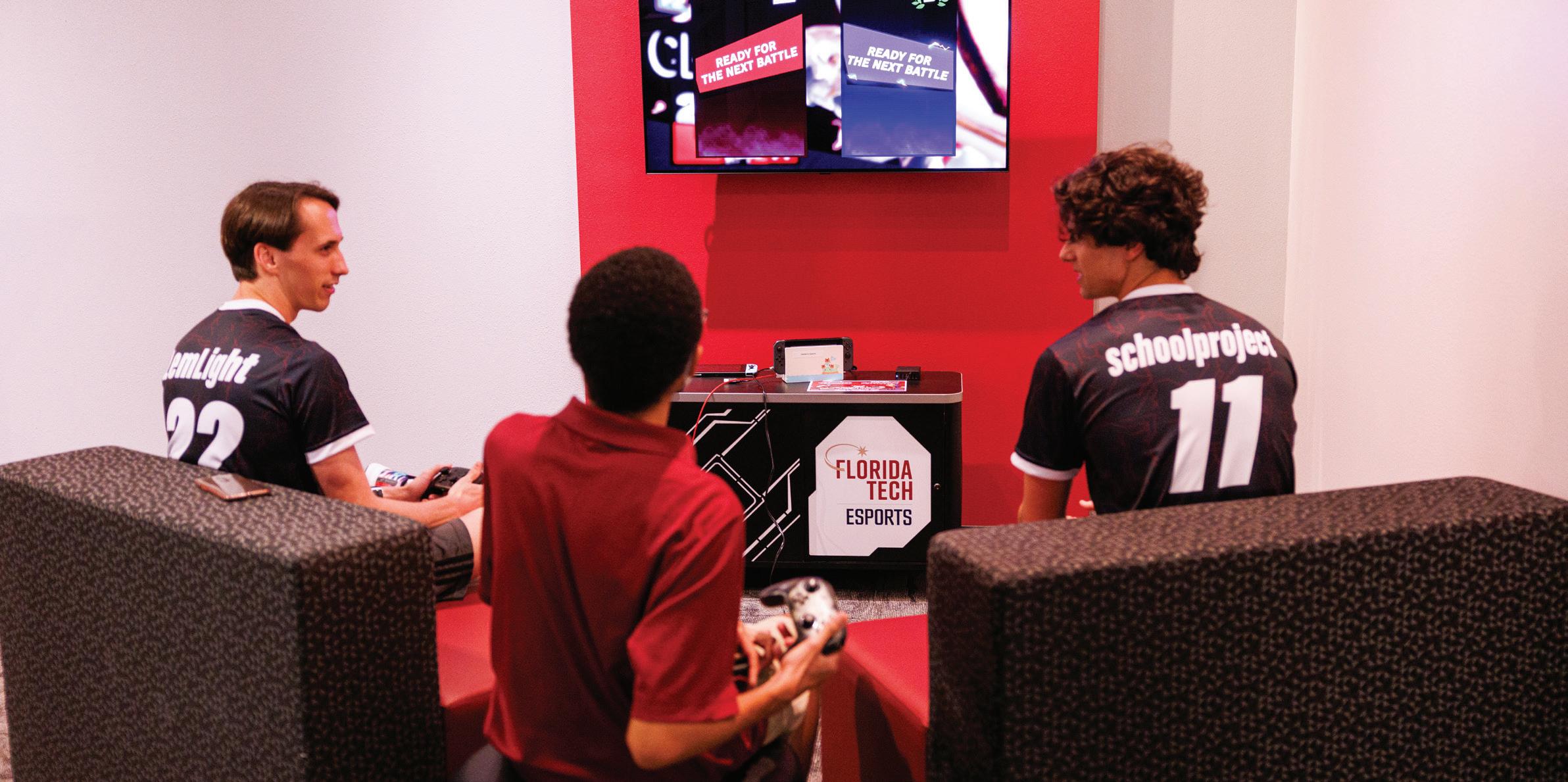

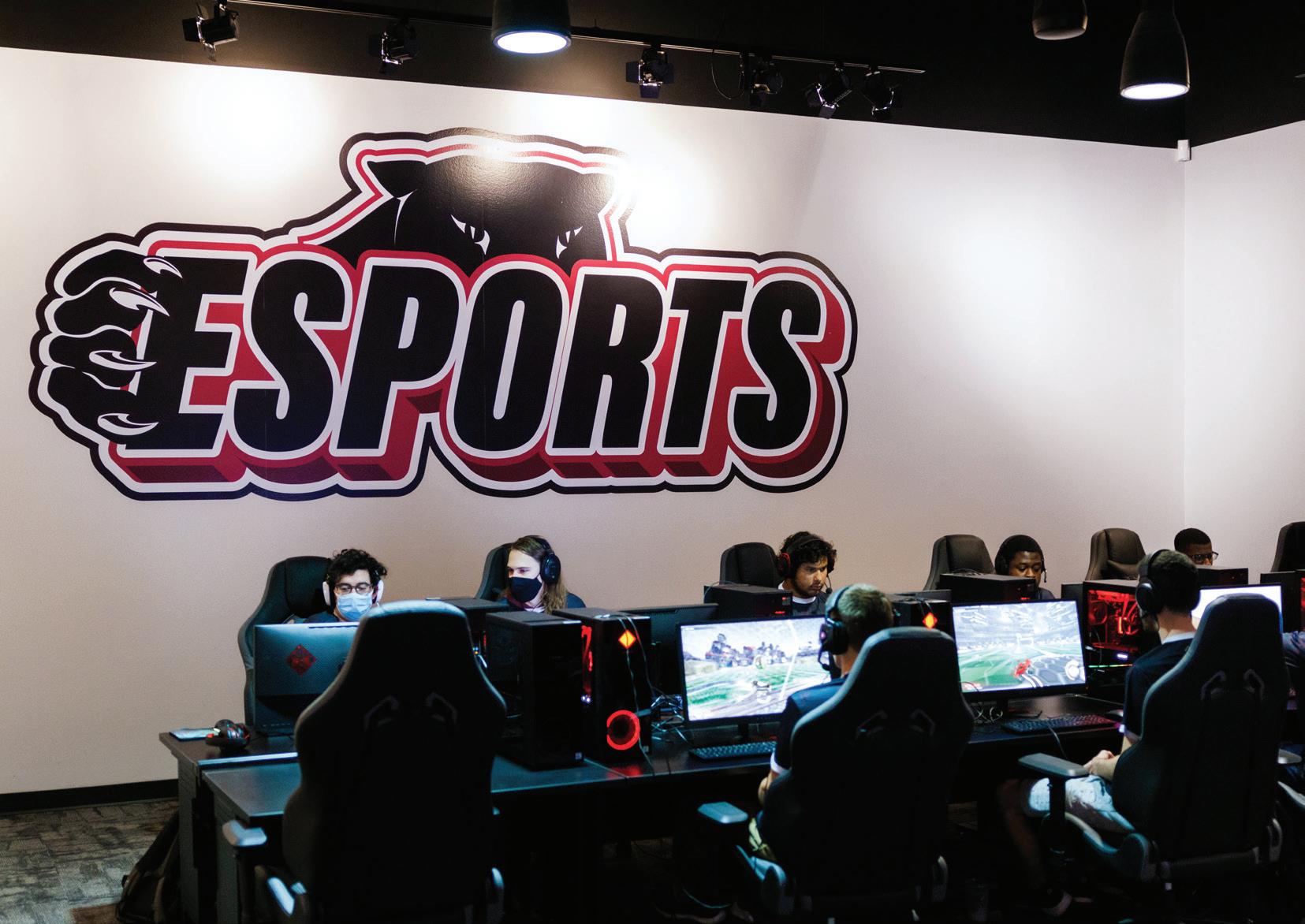



prizes, such as a new computer mouse.
“That’s where I fell in love with the competition,” he says. “I remember one day, we actually got to the finals, but we lost. None of us had any idea what we were doing, but we had a great time. I was there until 9:30 at night, so I got home, and my parents were like, ‘Where have you been?’ And I was like, ‘But I almost won.’”
After those amateur adventures, the Florida Tech team’s play was a harsh but welcome change of pace. Ryley says the

and there’s a software update for League of Legends. Now, my strategy is gone. Whatever champion I was going to play is out the window, and I have to figure something out in 30 minutes before we get into the game.”

transition to learning how to play a more organized game against far better players taught him the value of persistence. It also highlighted the importance of thinking on his feet, sometimes even more than when playing lacrosse.
“With traditional sports, you have all this training, and it almost becomes who can stick to a routine the longest and become the strongest from it,” he says. “But in esports, it’s so volatile. There are times when I’ve shown up to game day
In addition to cultivating adaptability, Florida Tech’s esports program is also designed to overlap with some of the university’s academic programs. The school’s Esports Center doubles as a home for the cybersecurity department, hosting classes, competitions and visits from prospective employers.
The esports program also works closely with the School of Behavior Analysis, with students observing verbal and nonverbal player behavior to monitor teams and offer workshops that help players develop as competitors and people.
“We don’t actually have a game design program or game animation as a major with us,” Dana says. “But we’ve used currently existing departments to see how can they also come into the gaming space with us. With the School of Behavior Analysis, the data that we’ve been collecting over the last three years hasn’t been taken anywhere else. So that’s really exciting in itself.”
Dana is excited to see the esports program serve as a gateway for visiting students who might not have known about the opportunities available at Florida

CLOCKWISE FROM ABOVE: Even for players who don’t compete on a team, the esports program can be an outlet for relieving the stresses of school and life. Florida Tech invested in a two-story, 5,800-squarefoot esports facility to give the program room to grow. A group of students gathers for a round of Super Smash Bros. PHOTOS COURTESY OF FLORIDA TECH ESPORTS
Tech. Drawn in by their interest in gaming, they might discover behavioral analysis only to find they also enjoy working in the same field with kids.
“Instead of working at a hospital, you might be able to get your research hours here through esports,” she says. “So that’s one really cool aspect that we can start to recruit people with. And it’s the same with cybersecurity. If your classes are taking place in a really cool gaming facility, that’s also a plus.”
Now a graduate student in Florida Tech’s chemical engineering program, Ryley says he routinely draws on his esports experiences as motivation in his academic work. As a researcher, esports has taught him to look for new solutions to a problem, even if everyone else approaches it the same way.
“You’re not going to get it right
the first time, and you’re probably not going to get it right the fifth time,” he says. “Even if someone else is doing it better than you right now, you can do it better than them later. It’s the same in school. You’ve got to allow yourself to not be thinking so rigidly about the world around you.”
Even if students don’t want to compete, participating in a robust esports program allows them to share their passion, connect with others and discover new opportunities, whether on campus or remotely.
“I think it gives those kids who don’t necessarily relate to traditional sports—who maybe don’t like watching football or soccer—it gives them something to be invested in and to have school spirit about that they might not normally have,” Ryley says. “I have Dana to thank because I’ve had some amazing years of my life because of the hard work she’s put in.”
While there are thousands of video game titles out there, a competitive game needs to have a certain amount of publisher backing so players know it will be around even as popular trends change. If you’re not game-savvy, the lineup can be confusing. Here are a few of the most popular:
League of Legends is a strategic multiplayer online battle set in a virtual arena. It’s a gaming staple, complete with diverse champions, complex strategies and a global following. The annual world championship keeps interest and participation high.
Combining soccer with rocket-powered cars, Rocket League has carved an esports niche. Gameplay is fast-paced and requires skill, with tournaments showcasing acrobatics and precise teamwork.
Nintendo’s iconic brawler features a roster of well-known gaming characters for competitors to use. Its gameplay is accessible for newcomers, but it has the depth needed to keep the attention of longtime players.
This tactical first-person shooter challenge requires precise gunplay and unique strategies. Its team-based action is great for tournaments and is an esports favorite.
Building on the success of its predecessor, Overwatch 2 includes diverse heroes and focused gameplay. It continues to be a favorite in esports. The game highlights the collaboration and skills of five-person competitive teams. The Overwatch League has franchises worldwide.





Graham Cracker Picnic Mix
¼ cup vegetable oil
¼ cup sugar
5 to 6 drops pink neon liquid food color
½ cup unpopped popcorn kernels

1 package mini pastel marshmallows
1 cup bear-shaped graham crackers
1 package white fudge-covered pretzels
1 cup mini cookies
In a large pot over medium heat, stir oil, sugar and food coloring. Stir in the popcorn kernels. Cover. Cook until popcorn begins to pop. Shake pot over heat until popping slows.
Remove pan from heat. Pour popcorn into a large bowl. Add marshmallows, graham crackers, pretzels and cookies. Toss lightly.
8 cups popped popcorn
2 tablespoons raspberry jam
3 tablespoons smooth peanut butter
½ cup white chocolate chips
¼ cup freeze-dried strawberries
¼ cup dried cranberries
In a large bowl, stir together popcorn and jam until evenly coated. Transfer to a parchment paper-lined baking sheet. In a double boiler over barely simmering water, add peanut butter and white chocolate chips. Cook, stirring occasionally, for 3 to 5 minutes, or until smooth and melted.
Drizzle peanut butter mixture over the popcorn mixture. Sprinkle with strawberries and cranberries.
Refrigerate for 10 minutes or until the peanut butter mixture is set. Break into pieces to serve. Store in an airtight container in the refrigerator for up to one week.
6 quarts popped popcorn
Olive oil cooking spray
1 cup grated Parmesan cheese
2 teaspoons garlic salt
2 teaspoons paprika
1 tablespoon Italian seasoning
Place popcorn in a large, sealable plastic container or a 2½-gallon plastic sealable bag.
Spray popcorn lightly with cooking spray. Sprinkle cheese, garlic salt, paprika and Italian seasoning over popcorn. Shake to distribute evenly.
12 cups unsalted, unbuttered, popped popcorn
4 cups mini marshmallows
2 tablespoons butter or light olive oil
½ teaspoon salt
1 tablespoon green food coloring
¼ teaspoon peppermint extract
1 cup green candy-coated chocolate candies
Place popcorn in a large mixing bowl. In a saucepan over medium heat, melt marshmallows, butter and salt. Stir occasionally until smooth. Remove from heat. Stir in food coloring and peppermint extract.
Toss marshmallow mixture with popcorn. Cool for 2 to 3 minutes or until cool enough to handle. Toss with chocolate candies.
Shape 3 tablespoons of popcorn mixture into a small cluster. Place on a wax paper-lined baking sheet. Repeat with the remaining popcorn mixture. Cool completely.
¼ cup freeze-dried strawberries, ground
6 cups popped popcorn
1 cup white chocolate chips, melted
In a small food processor or spice grinder, pulse freezedried strawberries until finely ground.
Place popcorn in a large bowl. Drizzle melted chocolate over the top. Toss until well-coated. Sprinkle evenly with ground strawberries. Toss until well-coated.
Scrape popcorn onto a large parchment paper-lined baking sheet, spreading into an even layer.
Let stand at room temperature for 30 to 60 minutes, or until chocolate is set and hardened. To serve, break into pieces.
5 cups popped popcorn
12 ounces white chocolate chips or chopped white chocolate
1 cup crushed hard candy peppermints
Cover a baking sheet with foil or wax paper. Set aside. Place popcorn in a large bowl. Set aside.
In a double boiler over barely simmering water, melt chocolate, stirring until smooth. Stir in crushed peppermints.
Pour the chocolate mixture over the popcorn mixture. Stir to coat. Spread onto prepared sheet. Cool completely.
When chocolate is cooled and set, break into chunks for serving. Store in an airtight container at room temperature.
8 cups popped popcorn
½ cup chopped toasted pecans
1⁄3 cup maple syrup
1 tablespoon bourbon
2 tablespoons butter
1 tablespoon orange zest
1 dash bitters
Place popcorn and pecans in a large bowl.
In a small saucepan over medium-high heat, combine maple syrup, bourbon and butter. Bring to a boil. Cook, swirling pan, for 3 to 5 minutes or until mixture thickens to corn syrup consistency. Stir in orange zest and bitters.
Drizzle maple syrup mixture over popcorn. Toss to evenly coat. Cool completely before serving.
Options: Substitute bourbon with rye or whiskey. For mocktail popcorn, substitute with nonalcoholic bourbon or whiskey.

My heart is heavy.
One of the true blessings of writing a column is the opportunity to share with you, my readers, not only what I see but what is on my heart. The two are often interconnected. As trite as it sounds, I feel like we are family.
In the wake of the most recent war atrocities, it’s challenging to keep my attention on things like photography and positive storytelling. Yet, even as I wade through the

emotions of these conflicts, I am reminded what a lifelong gift photography is, distracting me from deep and painful events while acting as a vehicle to share what I see and feel. For this, I am forever grateful.
Armed with a purpose, photography has always been a powerful communication tool. With it, we can shine light in dark places or quietly applaud acts of love and goodness. I believe both are necessary. While I truly admire the courage of my friends who risk their lives to show us the injustices and atrocities of war, I have chosen to celebrate light and those who reflect it.
Where there is light, there is hope. The new year is the perfect time to talk about seeing and being light. Whether
literal or metaphoric, light reveals and heals. Each of us chooses how we use light. With our cameras, as with our words, we can choose to focus on the good and lovely in our world or dwell on the dark, ugly and evil.
I attended a seminar where the speaker reminded his audience of the difference between a thermometer and a thermostat. One reads the temperature, and the other changes it, he challenged.
The late Agnes Baker Pilgrim—also known as Grandma Aggie, a Native American spiritual elder I wrote about a few years ago— said she talked to water, thanking it often. She insisted water hears us. I think light is similar. I know it has a voice. n
Show me the goodness of light, as it falls on mountains, fields, streams, rooftops, bedsheets or kitchen sinks. Or, as it springs forth from the heart in acts of kindness.
Email your best image (just one, please) with caption information, including an explanation of how it affects you, to GPH@pur.coop. We may share submissions on our website and social media channels.
How can rechargeable hearing aids that t inside your ear costs only $297 and be every bit as good as those that sell for $4,800 or more?
The answer: The MDHearing™ NEO uses the same kind of technology incorporated into hearing aids that cost thousands more at a small fraction of the price. Satis ed MDHearing customers agree: High-quality, digital, FDA-registered rechargeable hearing aids don’t have to cost a fortune. NEO is a medical-grade, digital, rechargeable hearing aid offering sophistication and high performance; and works right out of the box with no time consuming “adjustment” appointments. You can contact a licensed hearing specialist conveniently online or by phone — even after your purchase at no cost. No other company provides such extensive support. Now that you know... why pay more? PLUS... It fits inside your ear.

































Looking like a miniature aircraft carrier riding on massive tires, the swamp buggy crawls along a field edge smashing through brush and high weeds near Lake Okeechobee in south Florida.
Instead of jets, this flattop carries a deck festooned with old automobile seats where hunters sit in comfort. One deck below, crates contain excited dogs.
A 250-pound feral boar erupts from cover. Wanting to trap the animal alive, we release dogs to chase this tusked mammal through briar thickets and dense underbrush.
Domestic hogs first came to North America with early European explorers. In 1539, Spanish conquistador Hernando de Soto landed near Tampa, bringing a large herd of pigs to feed his troops. Some pigs escaped into the wild and multiplied.
Today, the pigs’ descendants number in the millions and populate more than 35 states, with the highest concentrations of feral hogs found in Texas, Florida, Louisiana and California.
Many people consider feral hogs among the most dangerous mammals in North America.
Bristling with razor-sharp tusks up to 3 inches long, a wild boar can inflict serious injuries. Leaner and more muscled than barnyard pigs, boars can weigh more than 500 pounds, but average between 100 and 300 pounds. A coarse hide covering a thick shield of hardened scar tissue draped over its head and bony shoulders protects its vital organs.
With armor, a bad disposition and few natural enemies, adult boars fear nothing—except dogs.
In a good spot, hunters release one to three strike dogs, such as curs, redbones or walker hounds. They alternate dogs during a hunting day. Strike dogs sniff out the pigs and chase them, nipping the hogs’ tail or back legs to make them stop, face the pack and fight.
Once strike dogs bay a pig, hunters send in a catch dog, typically a strong-jawed pit bull, often wearing a spiked collar and Kevlar vest for protection. The catch dog grabs an ear, snout, other

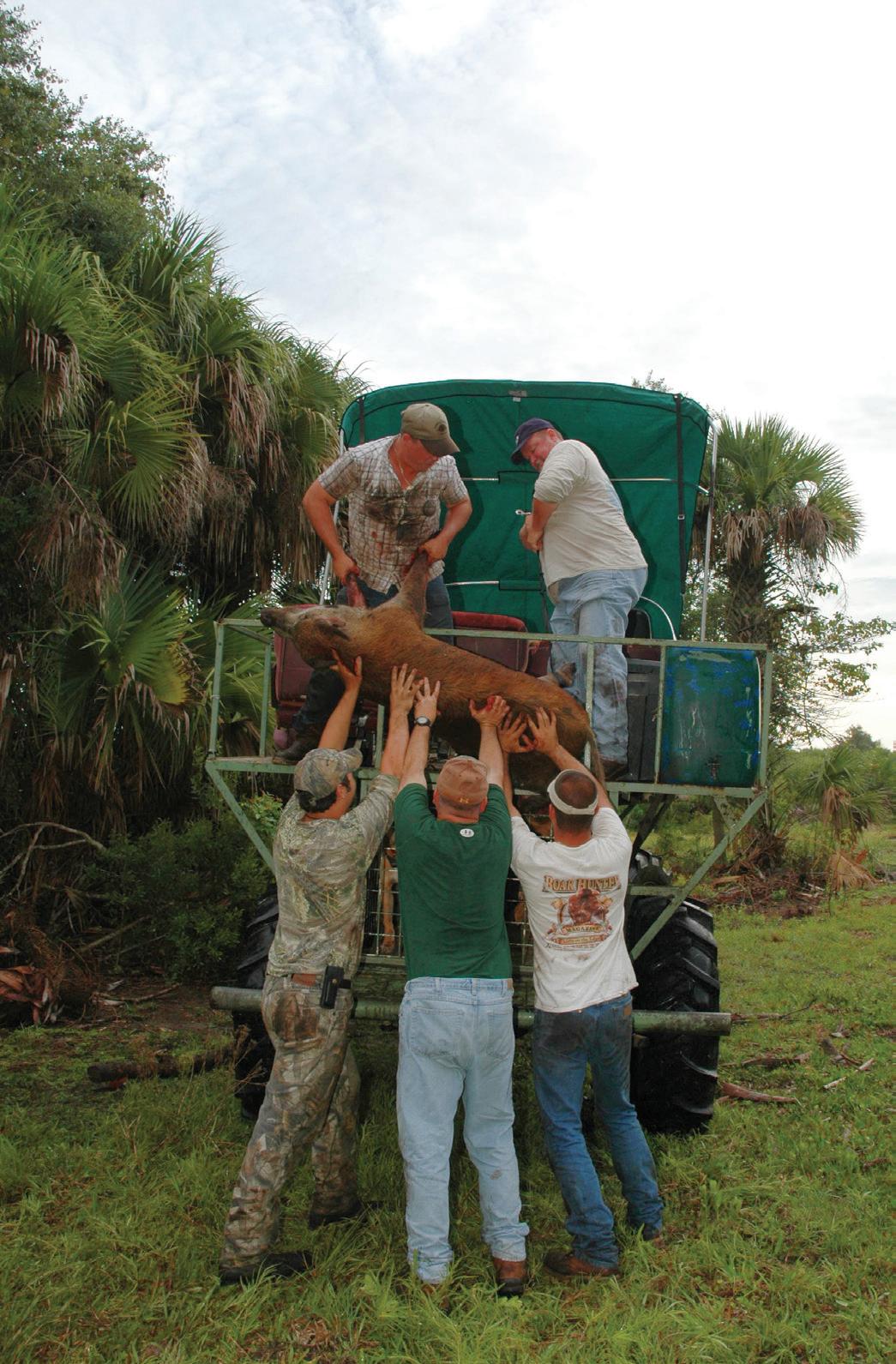
sensitive organ or whatever it can on an angry pig to immobilize it until the humans arrive.
After an exhilarating chase behind howling hounds and an adrenaline-pumping brawl at the bay, one or more hunters grabs the pig by its hind legs. This keeps it from moving and angles the porker’s head downward to prevent it from slashing people or dogs with its tusks.
With the pig held securely, someone kills it, customarily stabbing it with a large pig-sticker knife to avoid injuring any humans or dogs. Some people shoot the pigs with handguns.
Hogs populate every Florida county. The state allows hunters to hunt feral hogs all year on private lands. Some public properties allow people to shoot wild hogs as bonus game during other open seasons. The state even offers special hog-hunting opportunities on certain lands.
Because the highly prolific nonnative animals frequently destroy fences, eat crops and tear up wildlife habitat, many landowners welcome hog hunters onto their properties.
For more on Florida hog hunting, visit myfwc.com/hunting/ wild-hog.

John N. Felsher is a freelance writer, broadcaster, photographer and editor. An avid sportsman, he’s written more than 3,500 articles for more than 170 different magazines on a wide variety of outdoor topics. He also hosts an outdoor tips show for WAVH-FM Talk 106.5 in Mobile, Alabama. Contact him at j.felsher@hotmail.com or through Facebook.



Mighty Conifer Knife at an Impossible Price! $99 Impossible Price
What Stauer Clients Are Saying About Our Knives
“Outstanding knife of high quality and a great price. I now have a number of your great cutlery in my growing collection!”
— Robert F.,
Richardson, TX

e know you. You’re not interested in everyday, run-of-themill, common cutlery. You want something with a story, a unique feature that you can brag about. We’ve got just the thing for you. Our Mighty Conifer Knife is a unique tool with a Damascus steel blade and a handle crafted from an enhanced and stabilized natural pinecone. While our competitors are charging hundreds for similar knives, we’re offering the Mighty Conifer for JUST $99! That’s what we call our Stauer Impossible Price.


Join more than 389,000 sharp people who collect stauer knives EXCLUSIVE FREE
Each pinecone — and therefore, each knife — has its own unique characteristics. And the back of the handle features hand tooling, a further demonstration of each piece’s individual nature.
The blade is nothing to scoff at either. Constructed of Damascus steel, a modern reworking of the legendary steel forged by ancient swordsmiths, this nearly 5-inch blade features 256 layers of steel that have been folded on top of each other to increase its durability. Our competitors are charging hundreds for boring, run-of-themill knives with no features worth bragging about. We’re asking JUST $99 for a knife unlike any you’ve seen before!
With its full-tang construction and high-quality genuine leather sheath, the Mighty Conifer Knife is the perfect blade for the
person who wants to stand out. CALL NOW! If you’re one of the first 700 587 callers for this ad, we’ll throw in a pair of Stauer 8x21 Compact Binoculars — a $99 value — ABSOLUTELY FREE!
Satisfaction guaranteed or your money back!
Knife Specifications:
• 9 1/2" overall length. Full-tang construction
• Damascus steel blade and natural pinecone handle
• Genuine leather sheath
Mighty Conifer Knife
$299 $99* + S&P Save $200
*You must use Insider Offer Code: MCK145-01 to get this price.

Stauer 8x21 Compact Binoculars a $99 value with your purchase


California residents please call regarding Proposition 65 regulations before purchasing this product.
1-800-333-2045
Your Insider Offer Code: MCK145-01



All ages can find something new and exciting around every corner of the state. Filled with rich history, abundant natural beauty and diverse events all year, Florida has something fun for everyone.
January 1-16
First City Lights Festival
Navigate the eclectic historic district voted Florida’s Greatest Place as you experience live street performances, caroling in the streets and Winterfest Trolley Tours.
www.downtownpensacola.com; 850-434-5371
January 6 and 20
An Evening Under the Stars
Big Lagoon State Park, along with the Escambia Amateur Astronomer Association, invites you to spend an evening gazing at the skies. Clear skies permitting, telescopes and binoculars are set up to capture views of the moon, planets and other celestial objects. All participants must enter the park before sunset.
www.floridastateparks.org; 850-492-1595

January 13
Paws for a Cause
This dog walk to Pigeon Key benefits the Domestic Abuse Shelter of the Florida Keys. Registration begins at 8:15 a.m. at the beginning of the old 7-Mile Bridge. The walk starts at 9 a.m. Brunch is served on Pigeon Key. Bring your family and dog for a beautiful 4.4-mile walk.
305-849-6236
January 13
40th Annual Art Under the Oaks


January 6-7
Florida Keys Celtic Festival
This festival brings the rich cultural heritage of the Celtic nations to the heart of the Florida Keys. This family-friendly event features world-class musicians, performers, athletes, food, beer, and Celtic and Keys vendors. Children can enjoy arts and crafts, along with Highland Games events. This event is open 10 a.m. to 7 p.m. Saturday and 11 a.m. to 5 p.m. Sunday.
floridakeyscelticfestival.com; 850-529-0699

View fine art, original crafts and live entertainment in the San Pedro Church gardens. Enjoy refreshments, homemade bake sale goodies and raffles from 9 a.m. to 4 p.m. Admission is free, but onsite parking is $5. www.artundertheoaks.com; 305-852-5372, ext. 3








January 13-14
18th Annual Florida Keys Seafood Festival
Seafood and music combine yet again for this year’s festival at Bayview Park. From stone crabs and conch fritters to classic rock, this year’s festival brings timeless tunes and classic hits to the outdoor stage. Vendors are available for shopping, and a children’s area includes bounce houses and face painting. The $10 admission is good for both days. Children younger than 12 get in free.
floridakeysseafoodfestival.com; 305-743-0294


January 20
Kids and Kritters Mardi Gras Parade
This family-friendly Mardi Gras event is a walking procession for people and pets. The event begins at 1:30 p.m. in the Casino Beach parking lot with a pre-parade dance show. The parade begins at 2 p.m. www.pensacolabeachmardigras.com; 850-748-6878
January 21
12th Annual Tea
Enjoy an afternoon of dining on tea sandwiches, fruit breads and decadent desserts. Join the fun with the Country Girl Dress Up contest. Doors open at 1 p.m. and tea hours are 2 to 4 p.m. Tickets are $25 and can be bought at the Caladium Arts and Crafts Co-Operative, 123 Interlake Blvd. www.caladiumarts.org; 863-699-5940
January 26-27
Trash and Treasure Sale


The St. James Council of Catholic Women sponsors its annual Trash and Treasure Sale at the church’s Social Hall, 3380 Placid View Drive. The sale is one of the largest in the area with clothing, housewares, furniture, tools and fishing equipment included. Doors open at 8 a.m. and close at 2 p.m. Friday and 1 p.m. Saturday. www.stjameschurchlp.com; 863-465-3215
January 27
Pops in the Park
The Florida Keys Community Concert Band invites you to attend this free band concert in Peace Park. January’s event is Looney Tunes—Heroes and Villains. Pack a picnic basket and blanket or chairs, and load up the family and furry friends for this night of music. keyscommunityconcertband.org; 305-294-1123


January 15, 22 and 29
Florida Keys Concert Series


Delirium Musicum is a self-conducted, ethnically diverse chamber orchestra from Los Angeles composed of some of classical music’s top up-and-coming young artists. Other dates include January 22 with cellist Zlatomir Fung and January 29 with Shelest Piano Duo. Concerts start at 7:30 p.m. in the Marathon High School auditorium. www.floridakeysconcerts.com; 800-324-6982
January 27-28
Peace River Pro Rodeo Classic
Rodeo fans come to the Heartland of Florida and watch professional cowboys and cowgirls from across the nation compete. Gates open at 5 p.m. Saturday and noon Sunday at Hardee County Cattlemen’s Arena. Food and clothing vendors are onsite. www.peaceriverprorodeo.com; 863-773-4132



Want to share a family-friendly event with the readers of Florida Currents? Send details in an attached Word document (no PDFs, please)—in the format shown on this page—to info@floridacurrents.com. Include the date, town, times and a way for readers to register or get more information. Make sure to submit the item at least 60 days before the event (due to press deadline). If you own rights to a print-quality photo promoting your event— perhaps from a past year—include it with photo credit information.






Crapemyrtle is a versatile, drought-tolerant tree that produces dazzling blooms all summer long.
The tree is also a living sculpture during the winter, adding form and texture to the landscape. Late winter is the optimal time to prune crapemyrtles.
It’s important you know how to prune correctly so you can avoid topping—a practice commonly known as “crape murder.”
To properly prune crapemyrtles, use the following techniques:
• Remove suckers (small sprouts that develop along main stems or roots).
• Remove crossed, damaged or diseased branches. For crossed branches, remove the weaker of the two limbs that are crossing or rubbing.
Unfortunately, many homeowners and landscape professionals prune crapemyrtle trees too severely.
Topping can damage the tree and results in a “witch’s broom” appearance. Following this, the tree is no longer in proportion. Although topping may result in larger blooms, the flowers grow on thinner, weaker branches that droop and may even break. Topping can also shorten the life of the tree.
If you want to rehabilitate a “murdered” crapemyrtle, try one of the following options:
• Choose the strongest two sprouts from each stub, and remove the rest. This encourages remaining sprouts to grow stronger and opens the canopy of the tree. If you follow this procedure for a few seasons, the tree should improve in health and appearance.
• Cut the tree back to between 1 to 2 inches of the ground while the tree is dormant. After two to three weeks of growth, select three to five of the most vigorous new shoots on each trunk and remove all others. Remove any new shoots that emerge later. Within three to five years, you should again have a natural-looking crapemyrtle.
Spread the word to help eliminate crape murder. Use proper pruning techniques on your own trees or ask your yard maintenance professionals about their pruning techniques. Choose an appropriately sized plant for your site and prune sparingly to maintain beautiful crapemyrtles in your yard.
The UF/IFAS Florida Master Gardener Volunteer Program focuses on educating citizens about the science-based landscape and gardening information developed by the University of Florida. These volunteers share this knowledge with people in their communities to help conserve water, protect natural resources, and improve the lives of Florida residents. Visit UF/IFAS Gardening Solutions at gardeningsolutions.ifas. ufl.edu for more information on gardening in Florida.


Escambia River Electric Cooperative is pleased to announce the 2024 Herman D. Johnson Scholarship applications are now open.
Two $4,000 scholarships will be awarded to graduating seniors—one each in Escambia and Santa Rosa counties.
To qualify
• The student must be a high school senior with a GPA of 2.5 or higher.
• Their parents or legal guardians must be in good standing with EREC.

• Write a two-part essay.
• Provide three reference letters.
• Submit application and essay by March 1.
For scholarship applications, seniors should check with their high school guidance counselors; contact EREC’s Marketing and Communications at 850-675-4521 or 800-235-3848; or visit www.erec.com.
The deadline to submit applications is March 1. Winners will be announced at EREC’s annual meeting in April.

The study will analyze EV charging trends to prepare the South’s electricity infrastructure for the expected increased load


Optiwatt, the largest telematics‐based managed charging platform in North America, has partnered with PowerSouth Energy Cooperative to plan for increased energy demand as more electric vehicles hit the road in the Southeast.
Together, Optiwatt and 14 of PowerSouth’s distribution member systems invite EV owners in its service area across southern Alabama and northwest Florida to participate in the Electric Vehicle Research Pilot—a test program that monitors EV charging and its effect on overall demand. Users can receive a one-time $10 incentive for signing up and a $15 incentive at the program’s conclusion.





grid load optimization. Participating PowerSouth members include the city of Elba, plus Choctawhatchee, Clarke Washington, Coosa Valley, Covington, Dixie, Escambia River, Gulf Coast, Pioneer, South Alabama, Southern Pine, Tallapoosa River, West Florida and Wiregrass electric cooperatives.
“Our service territory has seen growth in EV use, particularly in pockets of coastal Florida and Alabama,” PowerSouth Member Services Coordinator Mike Majors says. “For EVs to be sustainable long term, we must position the grid to support increased electrification and new charging habits. This is what the Optiwatt partnership seeks to address.”

As the federal government and vehicle manufacturers target net‐zero emissions in passenger vehicles before 2050, and the Environmental Protection Agency considers legislation requiring 67% of new passenger vehicles to be electric by 2032, electric providers expect an increase in stress on the grid. This research pilot will help PowerSouth evaluate the potential impacts of EVs on the grid.
The program supports most electric vehicles on the road today, although plug‐in hybrids are excluded.
Upon enrollment, vehicles will be assigned to a research group to measure the impact of EV charging on

To enroll, participants must download the free Optiwatt app from the App Store or Google Play—or use a web browser—and follow the program instructions. The application will automatically enroll eligible participants in the program. To view frequently asked questions on the partnership and enrollment details, visit optiwatt.com/faq/powersouth.
Headquartered in San Francisco, Optiwatt is the largest telematics‐based home energy analytics platform in North America. The company’s partnerships with national utility providers and production consumer‐facing applications reduce costs and energy use for home and auto owners. For more information, visit getoptiwatt.com.




Cooperatives use the same set of seven principles to guide their work. One of the principles is open and voluntary membership. Membership in a cooperative is open to all persons who can reasonably use its services and stand willing to accept the responsibilities of membership, regardless of race, religion, gender or economic circumstances.
Oakley Jade Designs
“From my heart to your ears.”
Owner: Shelby White
shelbynw2001@gmail.com
Check it out on Facebook.


Making earrings started as therapy for Shelby White. She was grieving two very significant losses and needed an outlet to process her feelings and occupy her mind. Once she started selling to her friends and family and saw how happy they were with her product, her heart started to heal. She took that passion along with the love she had for her family and turned it into a business called Oakley Jade Designs. The business offers acrylic, hand-painted wood and clay earrings finished with hypoallergenic hardware.
Mention this ad during the month of January and receive 10% off your purchase.
Escambia County
Walnut Hill Snack Rations 8520 Highway 97 McDavid, FL snackrations@gmail.com
Check them out on Facebook.
Many have asked how freezedrying candy changes it or makes it better. The process of freeze-drying candy removes the moisture from within the candy and turns the otherwise chewy or hard candy into light, crunchy nuggets of flavor that melt in your mouth and don’t stick in your teeth. The freeze-drying time for most candy is four hours, but some candies require six or more than 12 hours. Choose from Skittles, Nerds Gummy Clusters, Jolly Ranchers and more. Make sure to get your order in.

Escambia River Electric Cooperative Inc. has filed with the federal government a compliance assurance in which it assures the Rural Utilities Service it will comply fully with all requirements of Title VI of the Civil Rights Act of 1964; all requirements of Section 504 of the Rehabilitation Act of 1973, as amended; all requirements of the Age Discrimination Act of 1975, as amended; and all requirements of the rules and regulations of the U.S. Department of Agriculture to the end that no person in the United States shall, on the ground of race, color or national origin, or solely by reason of such person’s handicap, or on the basis of age, be excluded from participation in, be denied the benefits of, or be otherwise subjected to discrimination in the conduct of its program or the operation of its facilities.
Under this assurance, this organization is committed not to discriminate against any person on the ground of race, color or national origin, solely by reason of such person’s handicap, or on the basis of age, in its policies and practices relating to applications for service or any other policies and practices relating to treatment of beneficiaries and participants, including employment, rates, conditions and extension of service, admission or access to or use of any of its facilities, attendance at and participation in any meetings of beneficiaries and participants, or the exercise of any rights such as beneficiaries and participants in the conduct of the operations of this organization.
The person responsible for coordinating the nondiscrimination compliance efforts of this organization is CEO Ryan C. Campbell.
Businesses hold small, rural communities together. Let’s keep local businesses thriving. From manufacturing and industrial to service and retail, businesses provide jobs to keep young people in the area and improve our quality of life. If your business is in Escambia River Electric Cooperative’s service territory and you want to have it spotlighted here, submit information to Cortney Owens at cowens@erec.com.
Any individual, or any specific class of individuals, who feel subjected by this organization to discrimination prohibited by Title VI of the Civil Rights Act, by Section 504 of the Rehabilitation Act, by the Age Discrimination Act, or by the rules and regulations of the U.S. Department of Agriculture may personally, or through a representative, file a written complaint with the Office of the Secretary, U.S. Department of Agriculture, Washington, D.C. 20250; the Office of Advocacy and Enterprise, U.S. Department of Agriculture, Washington, D.C. 20250; or this organization, or all, a written complaint. Such complaint must be filed not later than 180 days after the alleged discrimination, or by such later date to which the secretary of Agriculture of the administrator of the Rural Utilities Service extends the time for filing. Identity of the complainants will be kept confidential except to the extent necessary to carry out the purposes of the rules and regulations of the U.S. Department of Agriculture.
Sometimes, there are no words to describe your day—good or bad. Other times, days are long and tiring, so who wants to spend energy writing at the end of the night?
However, if you’re set on journaling in 2024, there are still options that can turn that dread into excitement.
Try taking writing out of the mix. Journaling doesn’t have to include words. Focus on visuals: drawing or doodles, graphs, daily Polaroids or creating pixels.
Documenting the year in pixels has been a favorite among bullet journaling in the past few years. Follow these six steps to set yourself up for an easy year of journaling:
• Find a piece of paper. This could be within a journal or a standalone piece. Keep it where you can find it at the end of the day.
• Choose five to 10 colors from your set of colored pencils, pens or markers. The medium you choose depends on how vibrant you want your pixels to be. Pens and markers tend to be brighter.
• On your piece of paper, draw a horizontal line at the top of the paper and a vertical line along the left side. Draw an additional 31 horizontal lines going down the page and 12 vertical lines across the page, creating little squares that become pixels as they

month above the columns. Along the left side, number the rows one to 31 downward.
• To the right side of the page, create a key. Match a color with an emotion or state of mind you were in that day.
• List emotions or states of mind you might feel throughout the year. Some useful ones are: good, happy, normal, routine, productive, lazy, unmotivated, angry and sad. To the left of these words, assign a color. You can choose as few or as many colors as you would like for your year.

SHE FOUGHT FOR HER COUNTRY. IT’S OUR DUTY TO FIGHT FOR HER.

Wounded Warrior Project ® long-term support programs provide these brave men and women whatever they need to continue their fight for independence. At no cost. For life. Help us help more of these warriors in their new life-long battle. Find out what you can do at fi ndWWP.org.




























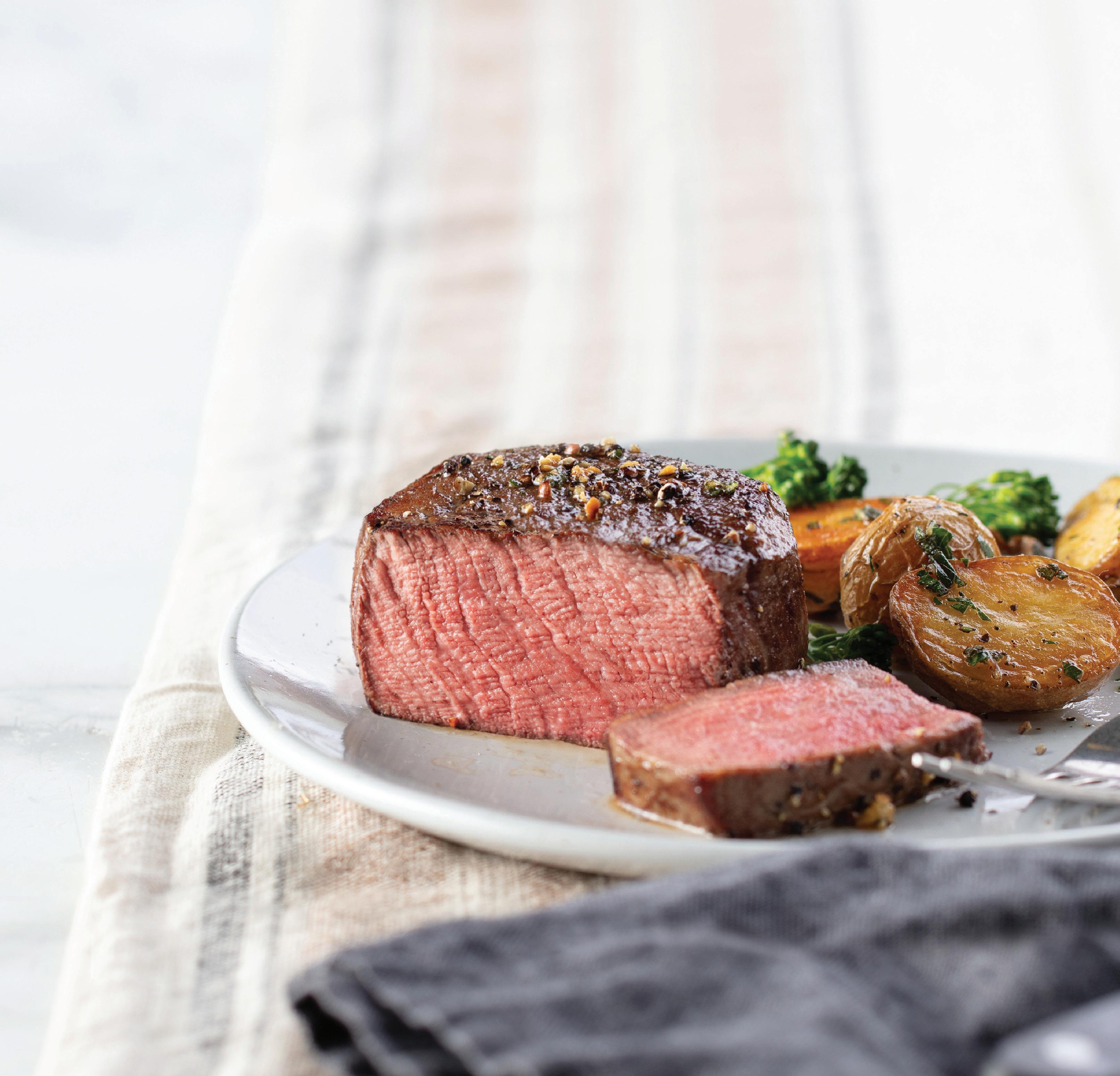























www.erec.com
JAY OFFICE WALNUT HILL OFFICE
3425 Highway 4 4950 Highway 99A
P.O. Box 428 (mail) Walnut Hill, FL 32568 Jay, FL 32565
PHONE NUMBERS
850-675-4521 800-235-3848
Walnut Hill Post O ce: 850-327-4122
OFFICE HOURS
7:30 a.m. to 4 p.m. Monday through Friday
STAFF
Ryan C. Campbell, P.E., CEO
Sonya Dooley, Director of Finance and Administration
Lanie Sells, P.E., Director of Engineering
Glenn White, Director of Operations
Cortney Owens, Manager of Communications
Derek Bridwell, Manager of Information Technology
Crystal George, Manager of Accounting
TRUSTEES
Escambia County
James E. Hall
Ernie Hester
J.D. Powell
Sam Walker, Vice President
Gary Wiggins
Santa Rosa County
Mickey Diamond
Rick Hunsucker, President
Ed Kelley
Wesley Scott
Dale Westmoreland, Secretary/Treasurer
The board of directors meets at 5 p.m. the third Monday of each month at the cooperative’s Jay office.
FOR POWER OUTAGES
Call 877-OUT-EREC or 877-688-3732. For emergency conditions, call 911.

When you call EREC with a question about your bill, please have your account number. This allows us to serve you in the most efficient manner possible. Your bill is due and payable upon receipt. Payment may be made by mail, at www.erec.com, at our night depository at the co-op office or in person at the co-op office. We ask you to allow five days for mail and delivery to ensure we receive your payment on time. Your electric service is subject to disconnection if payment is not received in the office by the collection date, even though you may have mailed the payment. Accounts not paid within 15 days from the date printed on the bill will receive reminder notices showing the account will be disconnected if not paid. Return check charge is $25 or 5% of the check, whichever is higher.